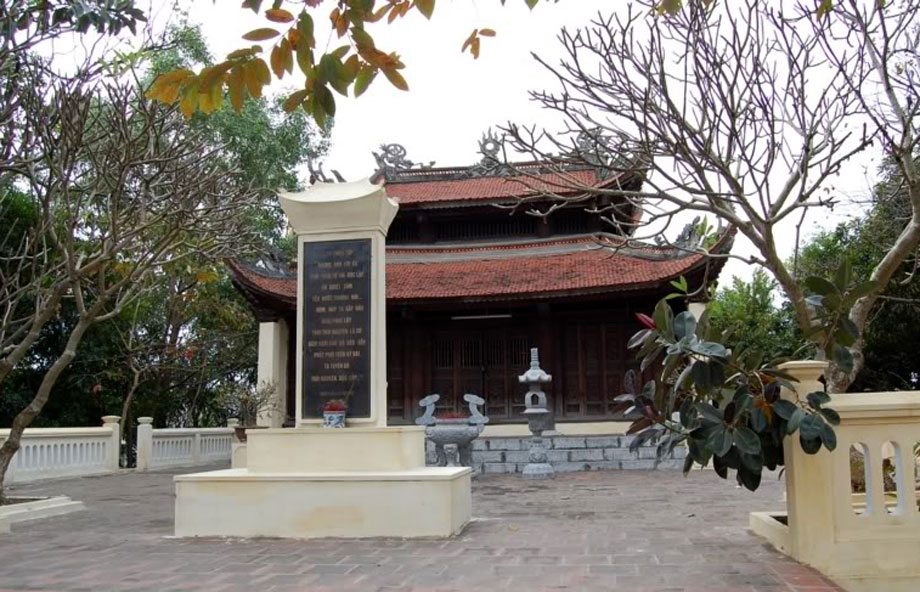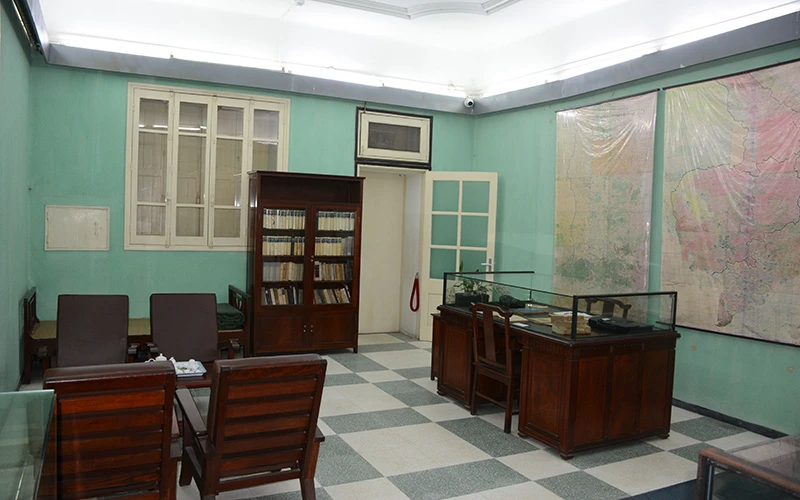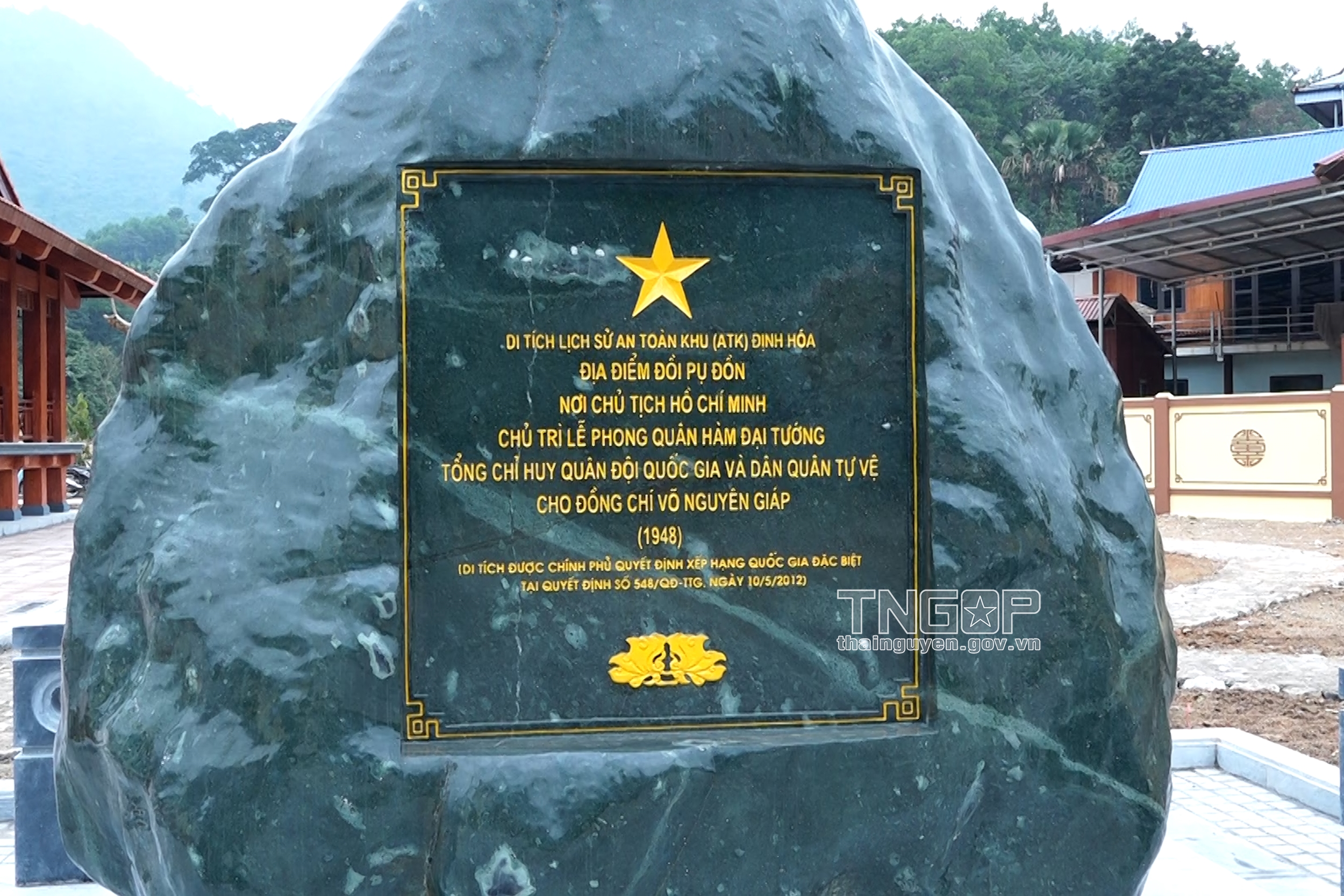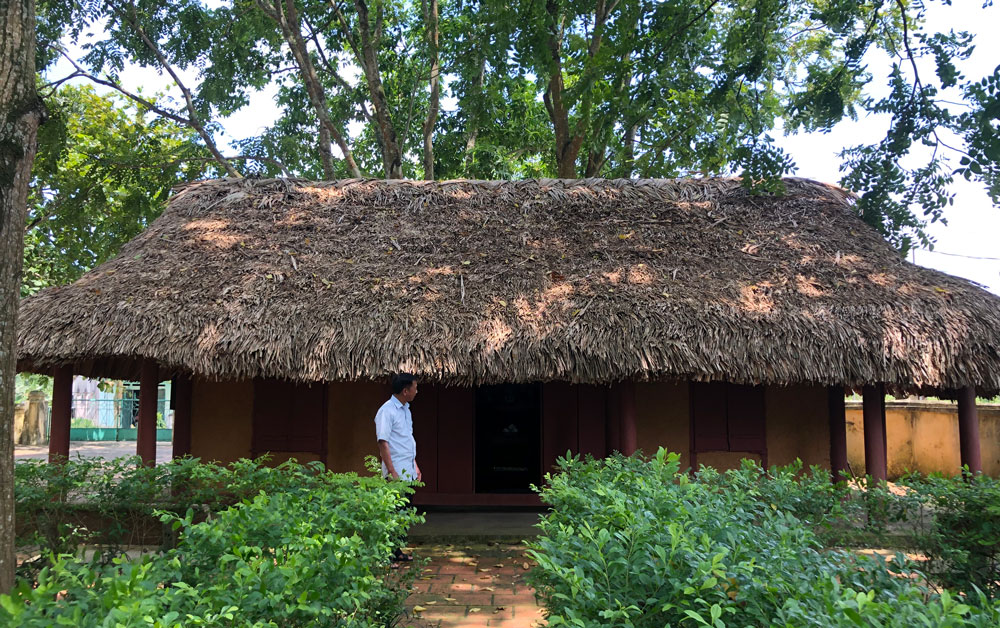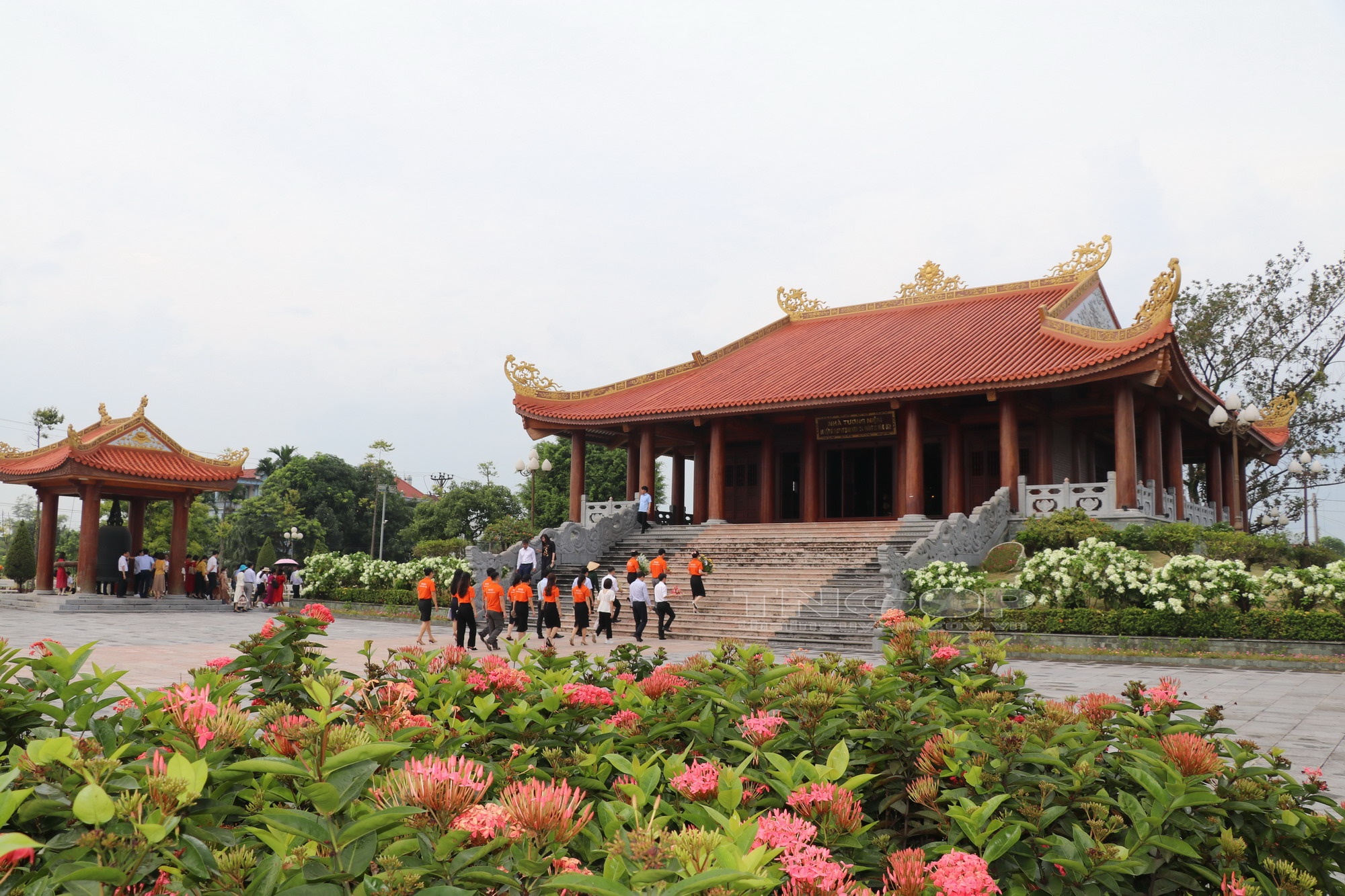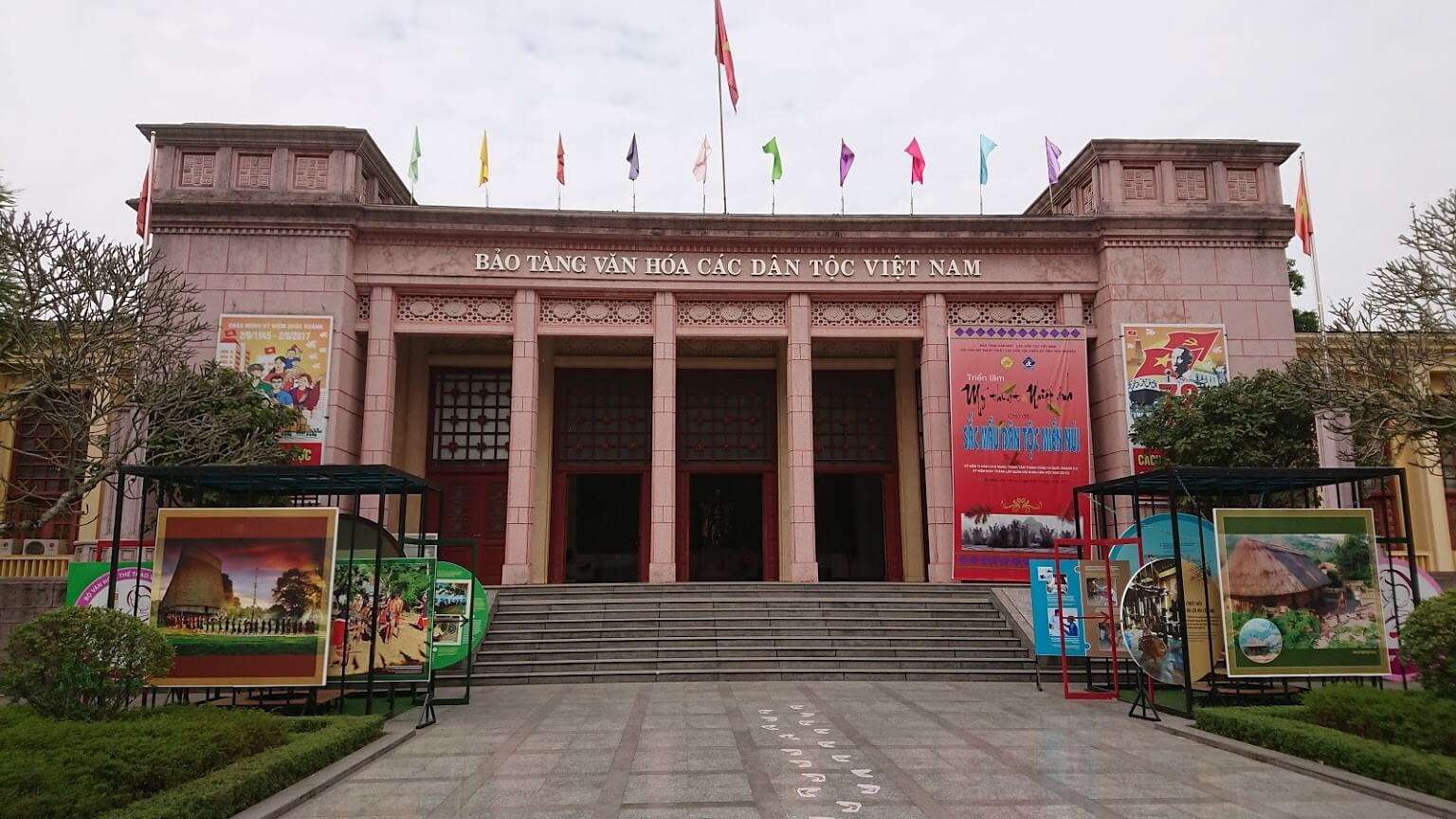Relic point Vietnam
Việt NamHistorical relic of Doi Can Workshop - Military Ordnance Factory k77
Historical relic of Doi Can Factory - Military Ordnance Factory k77 (1947-1954) in Dong Lan hamlet, Dong Thinh commune, Dinh Hoa ATK. On September 15, 1945, President Ho Chi Minh signed a directive to establish the Military Department under the Ministry of National Defense, with the following tasks: collecting, purchasing and organizing weapons production facilities to equip the army. Doi Can Factory (K77 Military Ordnance Factory) under the Military Department of the Vietnam People's Army is the main factory producing ammunition and weapons, making a great contribution to the victory in the resistance war against the French colonialists (1946). – 1954), building the foundation of the Vietnam Military Industry (now the General Department of Defense Industry) to contribute to the army and people of the whole country winning the resistance war against the French and the Americans to save the country, build and defend firmly. Surely Vietnam is a socialist Fatherland meaning. Doi Can Workshop and the Military Armament Workshops of the resistance war zones against the French colonialists nationwide contributed to the great achievements of the Vietnamese Military Sector. The Military Department (now the General Department of Defense Industry) was awarded many noble awards by the Party and State: Conferred the title of Hero of the People's Armed Forces in the resistance war against the French colonialists and the Americans to save the country. , Gold Star Medal, two Ho Chi Minh Medals, First Class Military Merit Medal, hundreds of Victory Medals, Labor Medals. 17 collectives and 58 individuals were awarded Hero of the People's Armed Forces and Hero of Labor in the Reformation Period, including 3 factories Z111, Z121, Z113 which were awarded Hero twice... Factory Relics Doi Can was invested by the Military Department and the General Department of Defense Industry to build a campus and fence with a complex of artistic ceramic reliefs "President Ho Chi Minh with Military workers" Additional exhibition house di Relics - library serving the people of Dong Thinh commune and visitors to the special national relic ATK Dinh Hoa, Thai Nguyen. Determined to be the origin of the General Department of Defense Industry at Viet Bac Base. The above historical relics have a particularly important meaning in the ATK Dinh Hoa Special National Relic Area complex and in the work of educating revolutionary traditions, studying and following moral and private examples. Ho Chi Minh's ideas and style. In order to promote the potential value of historical relics and perform the functions and tasks of the Management Board of Historical and Ecological Relic Areas ATK Dinh Hoa and Thai Nguyen, research and prepare scientific records based on historical values , cultural and scientific relics submitted to the Ministry of Culture, Sports and Tourism. On March 9, 2017, Minister of Culture, Sports and Tourism Nguyen Ngoc Thien signed Decision No. 814/DECISION OF THE MINISTRY OF CULTURE ranking national monuments for historical relic sites of the Ministry's agencies. The General Staff of the Vietnam People's Army and the residence and work of Chief of the General Staff Hoang Van Thai (1949 - 1954) and Decision No. 813/DECISION MINISTRY CULTURE SPORTS TOURISM historical relics Doi Can Factory - Military Ordnance Factory k77 (1947-1954). SOURCE: Management Board of ATK Dinh Hoa Historical-Ecological Relic Area, Thai Nguyen
Thai Nguyen 2884 view
Historical site: The residence and work place of General Vo Nguyen Giap
The historical relic site of the General Command of the Vietnam People's Army (1949- 1954) includes two main points: the residence and working place of General Vo Nguyen Giap and the Military Commission office on Don My hill (the hill jackfruit) and the office of the General Command on Khau Cuoi hill (banana forest) in Bao Bien village, Bao Linh commune, Dinh Hoa district. During the years of resistance against the French colonialists (1947-1954), Bao Bien was chosen by President Ho Chi Minh and our Party to be one of the central points of the Central base (Safety Zone - called ATK). ). There used to be leaders and commanders of the Ministry of National Defense living and working here such as comrade Ta Quang Buu - Minister of National Defense, comrade Hoang Van Thai - Chief of General Staff of the Vietnam People's Army at the communal house. Khen version. After the successful resistance war, Prime Minister Pham Van Dong and General Vo Nguyen Giap wrote many letters to visit and encourage ethnic people here, in the spring of 1989 and August 12, 1998, General Vo Nguyen Giap returned. Bao Bien, visited the place where he lived and worked in the past and the office of the General Command during the resistance war against the French. General Vo Nguyen Giap's living and working place and the district party office are located on Don My hill, looking ahead in the East-South direction to Bao Bien field, with a car road running through, cutting right in front. The relic is a newly opened village road, on the right and left are people's houses. Behind is the Lai Liep mountain range connected to the majestic Hong mountain range. Currently, through survey, we can see 5 different large and small house foundations covered by trees. Based on the size, location and testimony of witnesses, the large floor of the house is on top of the hill, with a cellar door in the middle that is a meeting and working place. In front is the guard house, behind is the kitchen, on the left is General Vo Nguyen Giap's house and the Military Commission office along with service staff, at the foot of the hill behind there is a luxuriant reed pond surrounded by fields. of the people. The Commander-in-Chief's office area is located on a low hill, facing the front about 700m East - South of General Vo Nguyen Giap's residence, surrounded on the right and left, behind is a palm forest. , in front looking up to the West - North is Bao Bien field. Through the survey, it was found that there are two adjacent house floors with clear traces, which are the large hall and the office of the General Command, in addition, there are many different large and small house floors scattered on Khau Cuoi hill, That is where our soldiers live to protect the Bao Bien base area. The entire Bao Bien historical relic site is located in a small narrow valley, surrounded by mountains and forests, very discreet, convenient for keeping secrets, but also very convenient for communication in all directions. From here you can easily go to Chu Market, Thai Nguyen, Cho Don - Bac Kan, Son Duong - Tuyen Quang. Bao Bien is the military headquarters of our Party, where General Vo Nguyen Giap, together with the Military Commission and the General Command, develops important military plans and submits them to the Standing Committee of the Party Central Committee for approval by President Ho Chi Minh. Approving, commanding, and directing many major campaigns, including the historic Dien Bien Phu campaign, Bao Bien has an important position in the history of our nation's resistance war against the French colonialists. Over time, due to the impact of nature as well as humans, the monument has been greatly degraded. The living and working place of General Vo Nguyen Giap, the Military Commission Office and the Office of the General Command were previously made of bamboo and wood, but no longer exist, traces of the floor are still relatively intact. Thanks to the awareness of protecting the relics of the people, both locations of the relic area were not damaged or encroached. In early 1996, according to the state's investment project to build the ATK area, a motorway was opened in front. At the center of the relic site, a road built with bricks and cement steps leading to the residence of General Vo Nguyen Giap and the Military Commission office, the national power grid is also being built. At the end of 1996, local people mobilized to build a motorway to the site of the Office of the General Command. Along with the relics in the Dinh Hoa ATK area, such as the place where the Vietnamese Propaganda and Liberation Army team merged with the National Salvation Army to become the Vietnam Liberation Army (May 15, 1945) in Dinh Bien. President Ho Chi Minh's relics in Keo province, Phu Dinh commune, passing Deo De Hong mountain is the Tan Trao historical relic site (Tuyen Quang)... forming a complex of revolutionary and resistance relics, convenient for traveling. tourist sightseeing. To promote the value of the monument, it is necessary to create a good environment for material and spiritual life, promote economic development, culture, education, raise people's knowledge in the region, and restore a At several important relics, a stele house was built to mark the event, and a guide sign was erected to welcome visitors regularly. The site of the relic site of the General Command of the Vietnam People's Army (1949 - 1954) in Bao Bien was ranked as a national historical and cultural relic by the Ministry of Culture and Information according to Decision No. 43/1999- QD-BVHTT, on July 12, 1999, the army and people of Bao Linh commune were honored as Heroes of the Armed Forces in the resistance war against the French colonialists. SOURCE: Management Board of ATK Dinh Hoa Historical-Ecological Relic Area, Thai Nguyen
Thai Nguyen 3170 view
Party Central Office
The site of the relic of General Secretary Truong Chinh and the Party Central Office working in Na Mon, Phu Dinh commune, Dinh Hoa district, Thai Nguyen province. The national resistance broke out (December 19, 1946), implementing the policy of "all-people resistance, comprehensive, long-term, self-reliant" to protect national independence, General Secretary Truong Chinh and his Office The Party Central Committee moved from Hanoi to Phu Tho, through Tuyen Quang, Deo Khe, Minh Tien (Dai Tu district)... The first stop of General Secretary Truong Chinh, comrade Le Van Luong and Mr. Le Duc Tho... At the Safe Zone (ATK) of Dinh Hoa, there are stilt houses of people in Quang Nap commune, now Binh Thanh commune, bordering Minh Tien commune, Dai Tu district, gateway to ATK, with a resistance village market, a town. quite crowded in early 1947 of the Viet Bac war zone. Moving together, setting up a working agency with comrade Truong Chinh, in addition to the Party Central Office, there are also the editorial department, reporters of the Party's Truth newspaper, and the Central Organizing Committee, which mainly moves around the foot of the mountain range. Hong from Diem Mac commune to Phu Dinh commune... (According to the story of Ms. Nguyen Thi Bich Thuan, former Deputy Director of the Police Department, wife of the late member of the Politburo, Head of the Central Organizing Committee Le Van Luong and her daughter visited the old place at ATK Dinh Hoa in 2006) Stopping in Quang Nap for a few months, the General Secretary and the Central Office moved to Khuoi Khe hill, Phung Hien hamlet (Thanh Dinh, now Diem Mac commune), then moved to Na Mon hamlet (Commune Phu Dinh), at the foot of Hong Mountain, near people, with fields spreading out in front. From here to Tham Khen hill where Deputy Prime Minister Pham Van Dong worked (1950 - 1953) is about 1km, 2.5km from Uncle Ho's Presidential Palace in Keo Province. You can follow the horse road to go over De Pass from Hong Mountain to Tan Trao (Son Duong, Tuyen Quang) for 6-7 km. During the resistance period, Comrade Truong Chinh and the Party Central Committee moved with Central agencies and President Ho Chi Minh from Dinh Hoa to Vo Nhai, to Cho Don (Bac Kan), to Son Duong, Champa. Hoa (Tuyen Quang)... then returned to live, work, and live with the Tay and Nung ethnic people in Na Mon village at the foot of Hong Mountain, Phu Dinh commune for the longest time from 1948 to early 1954. The Party Central Office in Na Mon is an advisory and assisting agency for General Secretary Truong Chinh, receiving instructions and reports from the Party Committees of provinces and inter-regions and is the place to broadcast policies, guidelines, and reports. resolutions, directives, and leadership nationwide. Here, many important directives, policies and resolutions were adopted, and major campaigns were launched such as the determination to liberate and open the border with our friend China (1950), the Trung Du campaign, and the Ha Nam campaign. Ninh, Hoa Binh campaign, Northwest campaign... Also here prepared political reports, expected personnel, organized the preparation of documents for the 2nd National Party Congress taking place in Kim Binh, Chiem Hoa, province Tuyen Quang in 1951… SOURCE: Management Board of ATK Dinh Hoa Historical-Ecological Relic Area, Thai Nguyen
Thai Nguyen 2692 view
Pu Don Hill
In an excited atmosphere, the entire party, people and army look forward to celebrating the 80th anniversary of the founding of the Vietnam People's Army and the 35th anniversary of the All-People's National Defense Festival, on the afternoon of December 9, 2024, in Tinh hamlet. Keo, Phu Dinh commune, Dinh Hoa district, Thai Nguyen province, the Command of Region I in coordination with the People's Committee of Thai Nguyen province solemnly organized the inauguration and handover of the renovation and embellishment project of the National Monument. Hill family Pu Don, belongs to ATK Dinh Hoa Special National Relic Area, Thai Nguyen. The project to renovate and embellish the Pu Don Hill National Monument began construction in January 2024, with an area of 3.32 hectares including the following items: Nghi Mon Gate; stone block with the name of the project; reception house; relic stele house; General Vo Nguyen Giap memorial house; stone screen; flagpole and other auxiliary items. After more than 10 months of renovation and renovation work, it has been completed and put into use to serve tourists inside and outside the province. After being inaugurated and put into use, Pu Don Hill National Monument along with other relics in the ATK Special National Monument Area will be a red address for officers and soldiers of the entire army to learn about traditional education sources. network, contributing to improving the promotion and introduction of the potential and strengths of the land and people of ATK Dinh Hoa, Thai Nguyen./. SOURCE: Department of Culture, Sports and Tourism of Thai Nguyen province
Thai Nguyen 2499 view
General's Hill
On January 20, 1948, at the Presidential Palace - a simple palm leaf roof in Khuon Tat (Phu Dinh commune), President Ho Chi Minh signed Decree No. 110/SL conferring the military rank of general on a number of leading officials - Army commander, General rank: Vo Nguyen Giap, Lieutenant General rank: Nguyen Binh, Major General rank: Nguyen Son, Le Thiet Hung, Chu Van Tan, Hoang Sam, Hoang Van Thai, Le Hien Mai, Van Tien Dung, Tran Dai Nghia, Tran Tu Binh. In a house built next to a large stream, leaning on one side of a mountain, the trees are densely covered, making it difficult to see from the outside and difficult for airplanes to search. A special gallery. There is a Fatherland altar, surrounded by red tape with slogans: "Long-term resistance war will definitely win", "Reunification and independence will definitely succeed"... looks simple but dignified. President Ho Chi Minh and Mr. Bui Bang Doan, Head of the Standing Committee of the National Assembly, stood on both sides of the altar, all Government employees stood in line in front of the altar (Mr. Cu Huy Can - Secretary of the Government Council, Phan My - Chief of Government Office)... President Ho Chi Minh held a decree calling Vo Nguyen Giap to the altar, then he remained silent, sobbing and shedding tears... An extremely touching minute, everyone was in tears. tear. After a while, President Ho Chi Minh spoke up and declared: In the name of the President of the Democratic Republic of Vietnam, I give you the position of General, so that you can command soldiers and soldiers to fulfill the mission entrusted to you by the people. falls for. Comrade Vo Nguyen Giap received the decree. The Head of the Standing Committee announced a few words in the name of the National Assembly. Mr. Phan Anh, on behalf of the Government, said a few words of congratulation. Ta Quang Buu - Minister of National Defense, on behalf of the soldiers, expressed congratulations to the entire army and raised the spirit of heroic struggle under the command of General Vo Nguyen Giap. Finally, comrade Vo Nguyen Giap stood up to thank President Ho Chi Minh, the National Assembly and the Government, declaring that he would continue to make efforts to fulfill his duties to bring independence and unity to the country, Vo Nguyen Giap said. Shake everyone's hand in turn. Then President Ho Chi Minh announced the closing of the ceremony. Marking this event, "Vietnam People's Police Guard, Chronicle History 1941-1954" is inscribed. “From the beginning of May to the end of May 1948, Uncle Ho's guards returned to Na Lom, Phu Dinh commune, right at Uncle Ho's children's camp next to Na Lom stream, about 200m from the old hill. Here, Uncle Ho and the Government conferred the military rank of General on comrade Vo Nguyen Giap"... The Management Board of Thai Nguyen relics and landscapes has compiled a scientific dossier to submit to the Ministry of Culture, Sports and Tourism to rank a national historical and cultural relic for the relic site of President Ho Chi Minh presiding over the ceremony. conferred the first military rank of General of our army, which marked an important historical event marking the formal and modern advancement of our army and the attention to training, disciplining and promoting generals. The Vietnam People's Army became a team of military leaders defeat invading enemies to protect the independence and freedom of the Fatherland.
Thai Nguyen 2731 view
Gia Bay Bridge
Gia Bay Bridge was built around 1928-1930. Previously, the bridge was located on National Highway 1B, the main road connecting Lang Son to Thai Nguyen. During the Indochina War, the bridge was destroyed by Vietnamese soldiers and people in 1947. In 1965, the bridge was hit by three bombs by US planes and was seriously damaged. In 1991, the bridge was newly built at the old location, with a length of nearly 100m and a controlled width of 9m. Gia Bay Bridge is a place with many historical marks, especially during the resistance war against American imperialism. History has recorded: On October 17, 1965, the American enemy mobilized aircraft 29 times, threw 116 explosive bombs at Gia Bay bridge and many series of missiles at the anti-aircraft artillery field of Regiment 210, opening began their war of air sabotage against Thai Nguyen. The massive destruction of the bomb caused two abutments of the Gia Bay bridge to be damaged, the main beam and the upstream and downstream side beams were broken, causing traffic to completely stop. American bombs killed and injured 147 people; 45 houses on both sides of the bridge burned and collapsed; 32 officers and soldiers in the Self-Defense Company of Hoang Van Thu neighborhood were injured. SOURCE: Department of Foreign Affairs of Thai Nguyen Province
Thai Nguyen 3032 view
Cluster of Thai Nguyen uprising relics
105 years ago, the Thai Nguyen uprising led by Doi Can and Luong Ngoc Quyen shook the French colonial government in Indochina. This is considered the most heroic armed uprising in our nation's history in the early twentieth century. Going back in history, in the early years of the 20th century, the people in Thai Nguyen province as well as the whole country suffered greatly from the oppression and exploitation of the French colonialists and their henchmen. In that situation, the patriotic children of their hometown Thai Nguyen raised the flag of insurrection, led by Trinh Van Can and Luong Ngoc Quyen. The uprising broke out on the evening of August 30, 1917. Doi Truong, Ba Chen and a number of enlightened soldiers came to kill the warden Noel and other powerful henchmen of the enemy. Mr. Doi Gia and his teammates came to kill a couple named Loet (Loet) - a very cruel prison guard, opened the prison door, broke the chains, and freed over 200 political prisoners and common criminals. Mr. Luong Ngoc Quyen was paralyzed and was carried out by his brothers. Next, Mr. Doi Gia opened the military food warehouse, took clothes and ammunition to equip the insurgents, then occupied the Consulate Palace, the courthouse, the courthouse, the wine warehouse, the ammunition warehouse... With tenacious fighting spirit, the insurgents took control of the province within a week. On September 5, 1917, the insurgent front in Thai Nguyen town was broken, forcing them to retreat from Thai Nguyen. Mr. Luong Ngoc Quyen was seriously injured and sacrificed heroically. Although it later failed, the uprising left a special milestone. For the first time in Vietnam's modern history, an uprising took place, seizing power in a province, having a declaration, declaring independence, having a national flag, a national name, and establishing its own army. The cluster of Thai Nguyen uprising relics was ranked Nationally in 1997, including relics: Green loincloth soldiers camp, French ambassador's palace, Thai Nguyen prison, Doi Can temple. SOURCE: Department of Foreign Affairs of Thai Nguyen Province
Thai Nguyen 3030 view
Ecotourism area, preserving traditional culture of the Tay ethnic group in Thai Nguyen
Located more than 10km from the center of Thai Nguyen city, Thai Hai eco-tourism area in My Hao hamlet, Thinh Duc commune, Thai Nguyen city has been a tourist area to experience Tay ethnic customs and traditions for many years. . Thai Hai Tay ethnic cultural conservation and eco-tourism area currently has about 30 stilt houses built according to the original stilt houses of the Tay people Dinh Hoa Thai Nguyen where you can enjoy Tay culture. same uniqueness Here, under the stilt houses clustered in the green space of palm trees, acacia forests, and vau forests in the mountains and hills, artifacts and traditional folk culture of the Tay and Nung Viet Bac people are preserved. Village Thai Hai's stilt house is divided into many areas with separate functions, including a conservation area, food area, entertainment area, event organization... and is an attractive destination that attracts domestic and foreign tourists.
Thai Nguyen 3014 view
Museum of Cultures of Vietnam's Ethnic Groups
Museum of Cultures of Vietnam's Ethnic Groups The Museum of Vietnamese Ethnic Cultures is located at No. 1 Doi Can, Trung Vuong, Thai Nguyen city (Thai Nguyen province), established in 1960 with the original name Viet Bac Museum, until 1960. 1990 changed name to Museum of Cultures of Vietnamese Ethnic Groups. With an area of nearly 40,000 square meters, this is a project that converges, stores, displays and introduces important documents about the history and cultural identity of ethnic communities in Vietnam. The Museum of Cultures of Vietnam's Ethnic Groups won the Ho Chi Minh Prize for architectural works, phase I, 2006. In particular, ethnic groups in areas such as the Delta, Northern Midlands, Northwest, Northeast, Central Highlands, Southern Delta... are recreated through nearly 50,000 artifacts in the museum space. In particular, the cultural identity of customs, labor practices, production, rituals, festivals, costumes, cuisine, architecture, crafts... are vividly recreated through the documentation system, tangible and intangible cultural heritage. SOURCE: Central Agency of the Communist Party of Vietnam
Thai Nguyen 2914 view
Khuon Manh forest relic
Khuan Manh forest relic Khuan Manh forest is a forest in Trang Xa commune, Vo Nhai district, 50 km northeast of Thai Nguyen city. This is the birthplace of the Party Central Committee to preserve and continue to strengthen its forces. On September 15, 1941, on behalf of the Party Central Committee's standing committee, Mr. Hoang Quoc Viet came to the base to witness the establishment and handover ceremony. Mission for National Salvation Army II, Mr. Chu Van Tan is the commander, Mr. Nguyen Van Phan is the deputy commander. At first the platoon had 36 people, including 3 women, but later increased to 46 people, equipped with rudimentary weapons, only pistols and spears. After the founding ceremony, the platoon began building a political base among the people, promoting guerrilla activities in Trang Xa and Dinh Ca, causing many losses to the enemy. In November 1944, many fierce battles between the National Salvation Army II (with the participation of local people) and the French army at Dong Thu bridge, Khe pass, La Han banyan tree, Da Do mountain, Mo Ga cave... these places mark the glorious victories of the Vo Nhai army and people at that time. SOURCE: World Travel
Thai Nguyen 2658 view
